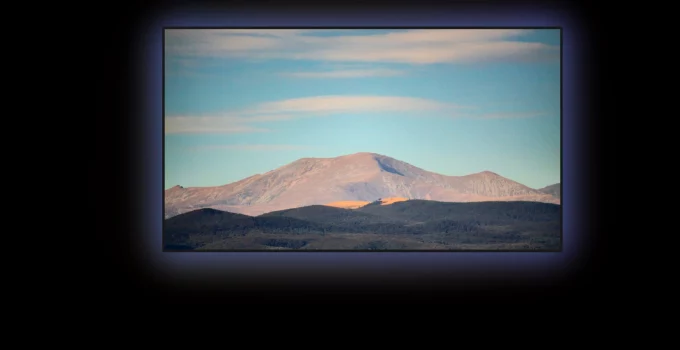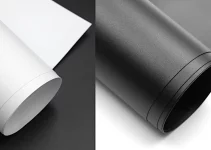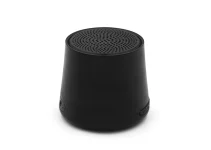I have to confess that personally I haven’t had any experience dealing and trying to fix projector light bleed so I’ve been very lucky.
As far as I am aware and from my experience of dealing with projectors since my early 20s, projector light bleed is really not that common and it will rarely happen.
Even so, let’s discover what is over-splash in a projector and, more importantly, what we can do about it.
Table of Contents
What Is Projector Light Bleed?
It’s pretty self-explanatory actually.
We have our projector that, hopefully for the best viewing experience, projects on a projector screen.
Instead of all the light being concentrated onto the screen, contained 100% by the projector screen material, it can spill out a bit either on top of the screen or on the sides. So it creates a halo effect or we can call it projector over-splash.
Some light spills out and it can happen especially on top of the screen. It’s like we have a small strip of white lights somewhat on top of our projector screen or maybe on the sides.
That’s what projector light bleed is.
We’re definitely more used to backlight bleed on TVs or monitors, although I managed to avoid that, too.
Does projector light bleed affect the overall image quality and our viewing experience?
Thankfully, no.
Image quality is not influenced negatively in any way by this halo effect so we’re totally safe on that.
Some people might not even be bothered about that very small band of light on top or maybe on the side of their projector screen.
On the other hand, if you have a very big screen and an amazing and expensive projector in a home theater setting and you notice a bit of that light where it shouldn’t be, then you might be bothered by it.
Let’s see if there’s any way to fix the projector over-splash.
Why does projector over-splash happen?
I will surmise that there’s a possibility that it has to do with not aligning our projector perfectly.
If we have a projector with horizontal lens shift, aligning your image can be done quite easily because we can use lens shift to get it right very quickly and perfectly.
If you only have a projector with keystone correction, the image aligning is mostly done by physically moving the projector.
So, we could say that the first thing we check out when we come across projector light bleed is to check out lens and keystone correction, we need to get our image aligned perfectly. If you are sure that’s not the case and everything is as it should be in this area, let’s move on to other factors.
How to Fix Projector Light Bleed
If I search on YouTube projector light bleed, which is what I usually do when I come across something that I haven’t encountered personally, I come across two videos.
Are these videos helpful?
Not especially helpful, from my point of view, but maybe it will be exactly what you’re looking for. I hope that’s the case.
One video is about the Epson LS800 light bleed or halo fix.
The person fixed it by adjusting the front legs of the projector so that’s definitely something that concerns this particular model since I really don’t think that it would apply to any other devices.
The second thing that person did was take the Epson app. The Epson LS800 comes with an easy setup app for iOS and Android so it seems that the app can solve this problem for us.
The second video concerns the Optoma P1 & P2 projectors.
It’s another video that refers to yet another app, this time the SmartFit app from Optoma. This app is an intelligent auto calibration app which solves painful manual adjustment when the customer is buying the Optoma ALR screen.
The solution actually involves placing some lights behind the screen, which sounds like a complicated and undesirable solution for me. I guess, don’t use the SmartFit app from Optoma and maybe don’t buy the Optoma ALR screen.
I love my Optoma, which is a Full HD and pretty cheap projector but the image quality is amazing. So it’s certainly not as expensive or 4K as the P1 or P2 but I don’t have any light bleed problems whatsoever.
Personally, I’m surprised to see videos about the Epson LS800 or the Optoma P1 & P2 projectors because these are expensive 4K laser projectors so I didn’t expect them to cause problems since my Full HD affordable Epson and Optoma never had these problems.
Does a good projector screen help with managing projector light bleed?
That’s a question that I’m interested in answering.
As we saw above, those two YouTube videos touched on apps that we can use for calibrating the image but there was no mention of whether a very good projector screen can help us avoid any projector bleed for all devices.
In order to do that, I will take the Silver Ticket Products STR Series as an example because it was my top recommendation as one of the best 4K projector screens. It’s not an ALR screen but it’s the best option we could make if our budget is around $200-$300.
The price for the Silver Ticket Products STR Series is amazing given the top-notch quality of their screens, their range of materials (white material, grey material, high contrast material, silver material, and woven acoustic material) and the wide range of screen sizes. 100 inch the lowest and 220 inch the biggest.
If we look at what buyers write about the Silver Ticket Products STR Series when it comes to projector light bleed, we will come across some interesting facts.
By the way, the Silver Ticket Products STR Series is also one of the highest rated projector screens, there are not many who don’t love it.
Besides all that, what also made me select the Silver Ticket Products STR Series as an example in our article discussing how to fix projector light bleed is one particular spec.
Light-absorbing frame
The manufacturer mentions that the frame is wrapped in light-absorbing black velvet material for a beautifully crisp viewing image.
Thus, that frame that is wrapped in light-absorbing black velvet material is supposed to prevent projector over-splash.
It is supposed to absorb over-projected light. The manufacturer mentions that we don’t have to be a professional when aligning our projector.
I also love that this fixed frame screen mounts on the wall easily, like a large picture frame.
What people say
Someone mentions that they’re using the Epson 3010 and their projector does not have much light bleed. So they don’t necessarily need the felt borders but they give it a very professional look.
Another buyer mentions that the positive of the Silver Ticket Products STR Series is the sleek look of the thin line border that results in tight tolerances to avoid image bleed off the screen.
There is a buyer that has tried the route of constructing their own screen from a cheap portable one stretched over a wood frame but it never looked right due to light bleed. All that went away when they decided to go for the Silver Ticket Products STR Series.
Yet another user mentions that the black velvet frame helps soak light bleed like a champ. It will trick our eyes into thinking the screen is darker.
Someone else mentions in their user review that the trim looks really nice and absorbs all the bleed from our projector.
So, let’s get back to answering our original question. Does a good projector screen help with managing projector light bleed?
Overall, my conclusion is that, while we can’t say 100% that a very good projector screen can guarantee that we won’t suffer from any projector light bleed, we could say with a fair amount of certainty that it certainly help prevent projector over-splash and it’s definitely an investment we should consider making for our set-up.




